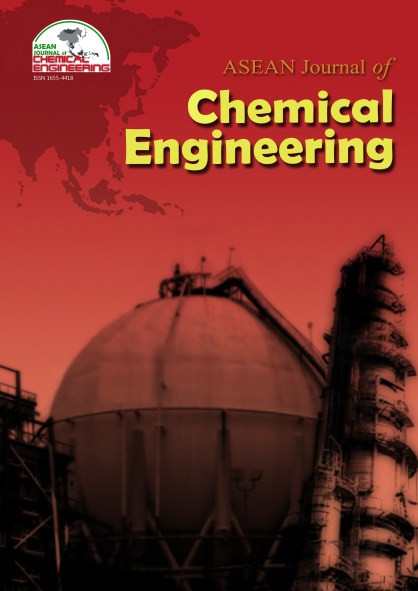Polyamide Chain Growth and Crosslinking: The Controlling Determinants for Properties of Thin Film Composite Membrane
Abstract
The desired features of a polyamide thin film composite (TFC) membrane for desalination can be tailored through careful control of membrane preparation condition. This work aims to provide more comprehensive understanding on polyamide film formation chemistry in order to correlate the membrane synthesis condition with its characteristics. Three series of TFC membranes were prepared by interfacial polymerization with adjustment of m-phenylenediamine (MPD) and trimesoyl chloride (TMC) monomer concentration as well as reaction duration. The membrane structural properties were evaluated based on glucose permeation then correlated with the transport and charge behaviors of membrane determined from pure water and inorganic salt permeation. During interfacial polymerization, competition occurs between polyamide chain growth and crosslinking. It was found that higher MPD concentration promoted polyamide chain crosslinking while increasing TMC concentration favored polyamide chain growth during diffusion-limited growth stage. Meanwhile, prolonged degree of polyamide chain growth and crosslinking occurred at longer reaction duration, which eventually caused self-limiting membrane growth. The water transport was primarily controlled by polyamide film thickness, porosity and hydrophilicity while size exclusion and Donnan exclusion worked in tandem in governing the salt separation. The TFC membrane synthesized at 3 w/v% MPD concentration and 0.10 w/v% TMC concentration under 60 s reaction duration achieved the best desalination performance with pure water permeability of 0.853 L/m2·h·bar and 81.4 % NaCl rejection.References
2. Atherton, J. H. (1994). Mechanism in two-phase reaction systems: coupled mass transfer and chemical reaction, in: R.G. Compton, G. Hancock (Eds.), Research in Chemical Kinetics, Elsevier Science B. V., Amsterdam.
3. Bowen, W. R., Mohammad, A. W., and Hilal, N. (1997). Characterisation of nanofiltration membranes for predictive purposes—use of salts, uncharged solutes and atomic force microscopy, J. Membr. Sci., 126, 91.
4. Bowen, W. R., and Mukhtar, H. (1996). Characterisation and prediction of separation performance of nanofiltration membranes, J. Membr. Sci., 112, 263.
5. Cadotte, J. E., and Rozelle, L. T. (1972). In situ-Formed Condensation Polymers for Reverse Osmosis Membranes, North Star Research and Development Institute, U.S.A.
6. Chai, G. Y., and Krantz, W. B. (1994). Formation and characterization of polyamide membranes via interfacial polymerization, J. Membr. Sci., 93, 175.
7. El-Aassar, A. M. A. (2012). Polyamide thin film composite membranes using interfacial polymerization: synthesis, characterization and reverse osmosis performance for water desalination, Aust. J. Basic Appl. Sci., 6, 382.
8. Fang, W., Shi, L., and Wang, R. (2013). Interfacially polymerized composite nanofiltration hollow fiber membranes for low-pressure water softening, J. Membr. Sci., 430, 129.
9. Fick, A. (1855). V. On liquid diffusion, Lond. Edinb. Dubl. Phil. Mag., 10, 30.
10. Freger, V. (2005). Kinetics of film formation by interfacial polycondensation, Langmuir, 21, 1884.
11. Hermans, S., Bernstein, R., Volodin, A., and Vankelecom, I. F. J. (2015). Study of synthesis parameters and active layer morphology of interfacially polymerized polyamide–polysulfone membranes, React. Funct. Polym., 86, 199.
12. Lee, J., Hill, A., and Kentish, S. (2013). Formation of a thick aromatic polyamide membrane by interfacial polymerisation, Sep. Purif. Technol., 104, 276.
13. Nightingale Jr., E. R. (1959). Phenomenological theory of ion solvation. Effective radii of hydrated ions, J. Phys. Chem., 63, 1381.
14. Petersen, R. J. (1993). Composite reverse osmosis and nanofiltration membranes, J. Membr. Sci., 83, 81.
15. Roh, I. J., Greenberg, A. R., and Khare, V. P. (2006). Synthesis and characterization of interfacially polymerized polyamide thin films, Desalination, 191, 279.
16. Rudin, A., and Choi, P. (2012). The Elements of Polymer Science & Engineering, Academic Press, Waltham.
17. Schaep, J., Van der Bruggen, B., Vandecasteele, C., and Wilms, D. (1998). Influence of ion size and charge in nanofiltration, Sep. Purif. Technol., 14, 155.
18. Song, Y., Sun, P., Henry, L. L., and Sun, B. (2005). Mechanisms of structure and performance controlled thin film composite membrane formation via interfacial polymerization process, J. Membr. Sci., 251, 67.
19. Soroush, A., Barzin, J., Barikani, M., and Fathizadeh, M. (2012). Interfacially polymerized polyamide thin film composite membranes: Preparation, characterization and performance evaluation, Desalination, 287, 310.
20. Sum, J. Y., Ahmad, A. L., and Ooi, B. S. (2014). Synthesis of thin film composite membrane using mixed dendritic poly (amidoamine) and void filling piperazine monomers, J. Membr. Sci., 466, 183.
21. Tomaschke, J. E. (2000). Interfacial composite membranes, III/Membr. Prep., 3319.
22. Yaroshchuk, A. E. (2001). Non-steric mechanisms of nanofiltration: superposition of Donnan and dielectric exclusion, Sep. Purif. Technol., 22, 143.
Copyright holder for articles is ASEAN Journal of Chemical Engineering. Articles published in ASEAN J. Chem. Eng. are distributed under a Creative Commons Attribution-NonCommercial 4.0 International (CC BY-NC 4.0) license.
Authors agree to transfer all copyright rights in and to the above work to the ASEAN Journal of Chemical Engineering Editorial Board so that the Editorial Board shall have the right to publish the work for non-profit use in any media or form. In return, authors retain: (1) all proprietary rights other than copyright; (2) re-use of all or part of the above paper in their other work; (3) right to reproduce or authorize others to reproduce the above paper for authors’ personal use or for company use if the source and the journal copyright notice is indicated, and if the reproduction is not made for the purpose of sale.



